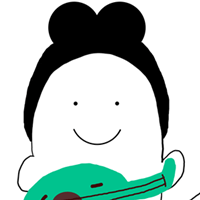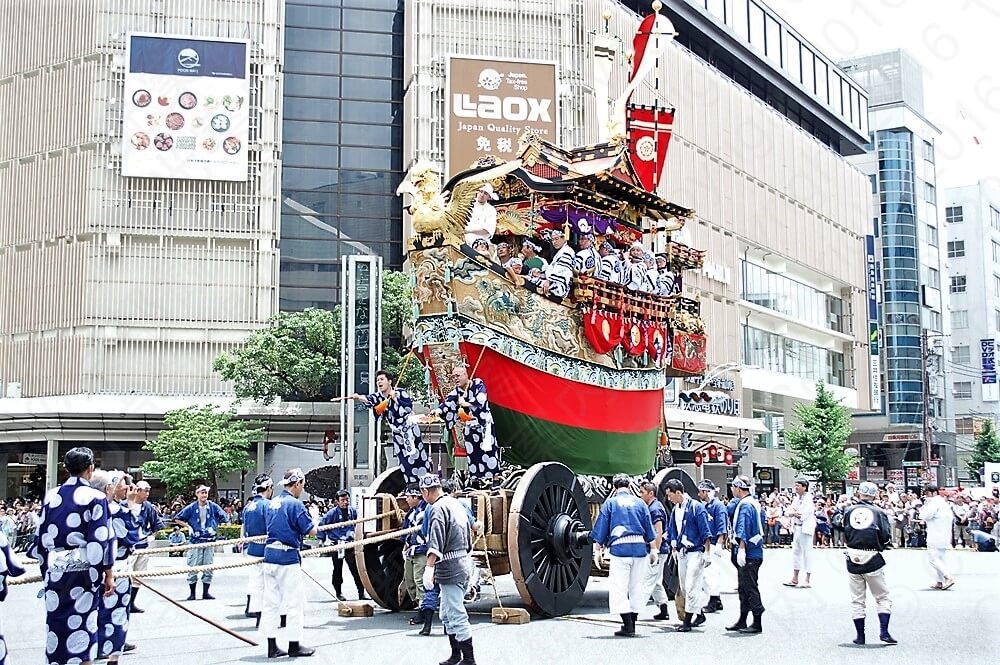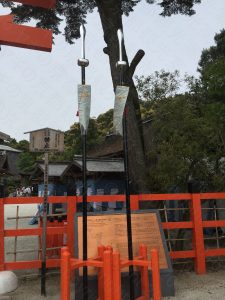- A short history of Yamhoko
- The Origin of Yamahoko in spirit
- The origin of Yamahoko in appearance
- Muromachi period 1336~1573 室町時代
- Ohnin no Ran 1467~1478 応仁の乱
- Enryakuji issue 1553 延暦寺との関係
- Honnoji no Hen 本能寺の変
- Tokugawa Iyetsuna passed away 徳川家綱逝去
- Kinmon no Hen 禁門の変
- Outbreaks of Cholera コレラ大流行
- The heavy rain 大雨
- Emperor Meiji 明治天皇容体悪化
- Emperor Meiji passed away 明治天皇崩御
- WWll
- The rail way construction
- COVID-19
A short history of Yamhoko
The Origin of Yamahoko in spirit
It is believed that the Yamahoko parade we know today began in the 13th century but the origin of Yamahoko is controversial.
Gion matsuri began in 869 for the purpose of put down Ekishin and bring the archipelago peace and calmness again: In the year, Japan suffered from earthquakes, maladie, epidemic and so on.
In The Gionsha Honen Roku, the archives of Gionsha temple (the former name of Yasaka Shrine) describes, “In 869, 66 Hoko(矛) were prepared in Shinsenen garden and Gionsha sent Mikoshi there.” This ritual is Gion Goryoe and Yasaka shrine claims it is the origination of Gion Matsuri fesitval.
The Hoko in Gion Goryoe must have resembled the ones in the photo. They are typical Hoko(矛) used in rituals. For example, we can see them in Aoi Matsuri festival. Actually I took the photo in the festival.
Hoko are usually prepared for getting rid of “Jaki ” or sometimes worked as Yorishiro. Jaki means something evil in the air. In the rituals in Japan, whether Shinto ones or Buddhist ones, many kind of way are taken for the purpose of getting rid of it. Gion Goryoe was a Buddhist ritual and Koko were supposed to be used for this purpose.
In addition to ti, Hoko also work as Yorishiro. In Gion Goryoe, there were 66 Hoko. At that time, Japan has 66 states.It is understandable that Hoko represented them and worked Yorishio for Ekishin in each state.
Yamahoko take after these role in spirit.
The origin of Yamahoko in appearance
In 999, Mukotsu Hoshi, i suppose he was a comedian, attended Gion Tenjine with what looked like “Shimeyama” in Daijosai. Shimeyama resembles Kakiyama.
Furthermore, Ouki, the dairy which describes the Imperial Court written by Fujiwarano Sanesuke in the 12th century, tells that Munaguruma marched with Mikoshi. Munaguruma was a mobile stage and many kind of performances took place. This Munagurma makes some contribution to Yamahoko because Buddhist story or Nogaku(Noh and Kyogen) on Kakiyama. Kakiyama were sometimes developed into Hikiyama and Hoko.
Muromachi period 1336~1573 室町時代
Though it is not clear what is the origin of Yamahoko, the parade takes place in the same way as we enjoy today began in Muromach period. People lives in the city made primitive Yamahoko and follow Mikoshi with them. In addition to it, some guilds also made Yamahoko. They were under the control of Gion sha and it gave them privileges to do their business. They made Yamahoko to show gratitude for it. One of the most prosperous ones is a guild of lumber merchants. As well as Yamahoko, it made a bridge for Mikoshi every year.
Yamohoko parade was so important for them that Yamahoko parade carried on though Gion sha didn’t send Mikoshi to the city for two decades due to some reasons.

In the decades, Yamahoko was developed. I suppose people wanted to enjoy Matsuri even though they could’t welcome Mikoshi. (Mikoshi is the most important thing in Gion Matsuri. Check this article!) The parade was not only for the denizens of the city. For example, Ashikaga Yoshimitsu, the founder of Kinkakuji temple, also admired the parade!
Ohnin no Ran 1467~1478 応仁の乱
Ohinn no Ran, the largest civil war Japan has ever experined, devastated Kyoto and its suburb area. Owing to it, Kyotoites thirsted for Gion Matsuri in vain from 1467 to 1499. In 1500, it took place for the first time in 33 years. After the war, 58 Yamahoko was reduced to 37 and Guilds haven’t offer Yamahoko since then.
Enryakuji issue 1553 延暦寺との関係
In 1553, Enryakuji couldn’t cerebrate the Matsuri of Hiyoshi sha. In the Shito-Buddhisim fusion, Hiyoshisha was a Shito shrine which saved Enryakuji. Enryakuji asked Muromach Shogunate to cancel Gion Matsuri in Goso.
Goso is a way prosperous Buddhist temple like Enryakuji often took to make their will accepted by Shogunate: Monks in Saumrai armor visited Imperial palace with Mikoshi. When their claim was denied, they left Mikoshi there. In the time, Deities, even a good ones, made people scared because they thought that once they got furious, they were at a loss for coping with them. With Mikoshi, their claim was equivalent to the words of Deities in there and the Shogunate couldn’t turn down their request.
Enryakuji claimed: It is not reasonable that Gion matsuri was held though Enyakuji commemorate the Matsuri of Hiyoshisha. At that time, Gion sha was a sub-temple of Enryakuji.

For Enryakuji, it was not good idea to held Matsuri of sub-one though the main-one couldn’t do that.
Muromachi Shogunate approved the claim and Gion Matsuri was canceled. When it was canceled, some Kyotoite said the famous line sometimes quoted: 「神事これなくとも、山鉾渡したし」It means “We want to do Yamahoko Parade without ritual, i.e., Mikoshi.”
In 16th century, Enryakuji often made Goso and Gion matsuri was canceled or postponed.

One year, Gion matsuri was postponed and took place in the new year’s eve!
Honnoji no Hen 本能寺の変
In 1582, Honnoji no Hen occurred and Oda Nubunaga ceased to exist and Gion matsuri was postoponed and held in November.
Tokugawa Iyetsuna passed away 徳川家綱逝去
As mourning, Gion Matsuri was canceld in 1680.
Kinmon no Hen 禁門の変
Due to Kinmon no hen, a large rebellion against Tokugawa Shogunate in 1864, the parade of Sakimatsuri was canceled in the following year.
Outbreaks of Cholera コレラ大流行
Year 1879, 1886, 1887, and 1895 experienced the outbreaks of Cholera and Gion Matsuri was postponed to autumn.
The heavy rain 大雨
The heavy rain during the parade in 1884 made it postponed.
Emperor Meiji 明治天皇容体悪化
In 1912, Emperor Maiji’s condition got worse and Atomatsuri was canceled.
Emperor Meiji passed away 明治天皇崩御
As mourning, Gion Matsuri was postponed to August in 1912.
WWll
Due to the second war, Gion Matsuri was canceled from 1943 to 1946.
The rail way construction
In 1962, to build station of Hankyu rail ways, Yamahoko parade was canceled.
COVID-19
In 2020, Yamahoko parade was canceled for the first time in 58 years.




